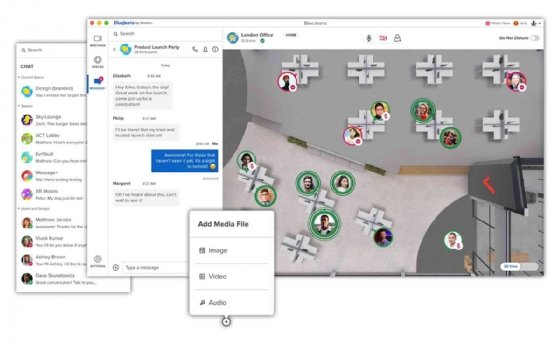Social collaboration tools create hybrid work water cooler
Traditional collaboration tools have struggled to replicate casual office conversations. New social collaboration tools could help reduce the isolation of remote and hybrid work.
Cloud-based collaboration tools have clearly helped employees maintain communications amid the COVID-19 pandemic and subsequent hybrid workplace format. But many employees are struggling to maintain the casual connections that come with working in the office.
For some employees, the lack of casual conversations in the break room or by a co-worker's desk creates a feeling of isolation -- even when they participate in virtual meetings.
According to a 2021 Wainhouse Research survey of 2,000 knowledge workers, more than half of respondents felt more socially isolated than before the pandemic. Respondents who work in a hybrid workplace model, in particular, felt more isolated as they struggle to balance remote and on-site work.
New types of virtual collaboration tools are emerging to address the growing need to support company culture and casual communications in the remote and hybrid workplace.
Social collaboration: New market or product feature?
Wainhouse defines social collaboration as "two or more people working together outside the context of a structured meeting." The debate is whether social collaboration is its own market or a feature that's part of a larger collaboration suite, Wainhouse analyst Sean Spradling said.
Spradling said he believes social collaboration tools are their own market as they are trying to achieve their own goals separate from traditional collaboration tools.
Social collaboration apps can be audio-only, be video-enabled or provide persistent virtual spaces that can replicate physical locations. These apps address three types of engagement:
- Team. These apps are intended for smaller group communication to bring together teams who may not be working in the same location or time zone. They facilitate persistent and synchronous engagement from team members. Team engagement apps include Frameable, Slack Huddles and Tangle.
- Topic. Topic engagement includes work discussions, as well as casual topics, like hobbies, that extend beyond communication within a team. These apps support larger groups and offer a mix of synchronous and asynchronous communication. Topic engagement apps include Clubhouse, Discord and Zoom Huddle View.
- Serendipitous. These apps provide both team and topic engagement for groups of any size. Serendipitous apps support the casual communications akin to water-cooler conversations. Apps of this type include BlueJeans Spaces, Gather and Teamflow.

Supporting casual communication in hybrid work
Virtual happy hours in Microsoft Teams or Zoom serve as social events for remote employees during the pandemic. But facilitating social events over video conferencing platforms is contributing to meeting fatigue, said Steve Gottlieb, founder of social collaboration app Watercoolr and virtual events platform Shindig.
In conferencing apps, users don't have the autonomy to choose who they talk to or have quiet side conversations. Social connections are an important piece of why employees stay with their jobs, he said.
"The extent you don't nurture that, you do so at your own peril," Gottlieb said. "The need to connect hybrid teams is really critical."
Watercoolr is built off Shindig and integrates with single sign-on to connect employees using collaboration apps like Slack, Teams and Zoom with Watercoolr's communal lounge. Simultaneous private video conversations can then happen inside the lounge.
Bramble, another social collaboration tool, creates persistent virtual spaces to support team-based and spontaneous engagement. The app was originally built to support creative communities during the pandemic when restrictions prevented in-person performances and events.
"We did what most communities did in our situation; we went virtual," said Vladic Ravich, co-founder of Bramble. Bramble enabled musicians and artists to gather virtually for small events, as well as facilitated large virtual events, such as an international folk music festival.
Bramble supports spontaneous communication by providing users with the ability to decide who they want to talk to and where within a 2D virtual environment. The app uses spatial chat to facilitate conversations based on a user's proximity to others in the virtual space.
"This was extremely useful not just for creative communities, but for anyone who wanted to have this engagement with teams," Ravich said.
Companies can recreate their physical office spaces or design custom spaces for product launches, employee onboarding and training, happy hours and birthday celebrations. Bramble also goes beyond casual communication through integrations with productivity tools, like Mural and Notion, to support team workflows.
Unified communications vendor approach to social collaboration
Some unified communcations (UC) and collaboration vendors, like BlueJeans, Slack and Zoom, have introduced social collaboration features. Larger market players could complement their portfolios with social collaboration tools.
Inevitably, the market will shake out with the leading vendors and acquisitions of smaller players, Metrigy analyst Irwin Lazar said. It's also possible large vendors, like Microsoft and Cisco, could acquire startups to integrate persistent virtual spaces with workplace experience platforms, he said.
Microsoft and Cisco could also develop their own social collaboration tools instead, Spradling said. Their collaboration offerings already have the fundamental capabilities of presence, identity and Web Real-Time Communications to build on.
Cisco, for example, could integrate a social collaboration capability with its cloud-based location services platform DNA Spaces. DNA Spaces enables employees to see a 3D layout of the office, reserve desks and meeting rooms, and view occupied spaces.
Cisco could take DNA Spaces a step further by adding a persistent virtual space to bring remote and in-office employees together, Spradling said.
"That's real hybrid than just trying to accommodate both in silos," he said.
However, major UC vendors would only enter this market if they view it as big enough to pursue or if they want to leapfrog into developing apps for the metaverse, he said.
Gaining end-user buy-in
Social collaboration apps also cross into the HR domain, Lazar said. With the rise of remote and hybrid work, there is a greater need for HR and IT to work more closely together on technology purchases that drive employee engagement.
Senior leadership also needs to be more intentional in how they plan for the future of work, Gottlieb said.
"We were relying so much on long-term choices of office architecture to dictate how social our office was," he said. But, now, business leaders need to unify teams across different types of locations. Social collaboration apps could be a more long-term option to support engagement.
But a key challenge for social collaboration tools is getting buy-in from users who already juggle multiple apps as part of their daily workflows. Simply supporting casual engagement doesn't seem to be a huge selling point, Spradling said.
"Every time you layer another app on, it gets worse -- the cognitive load," he said. But, when social collaboration is combined with workflows, it starts to make more sense, he said. This becomes the crux of the feature versus standalone market debate, he said.
Slack Huddles, for example, enables users to launch informal, ad hoc audio calls from a channel or direct message. Slack also recently announced video and screen sharing capabilities for Huddles.
While treating these apps as an add-on to collaboration workflows can support adoption, organizations need to figure out how to ensure the apps will be continuously used and not just a novelty that will be used a few times, Lazar said.
"We're at the point now where we'll see 100 apps, but only a handful get adopted, and they have to integrate with core collaboration apps," he said.







